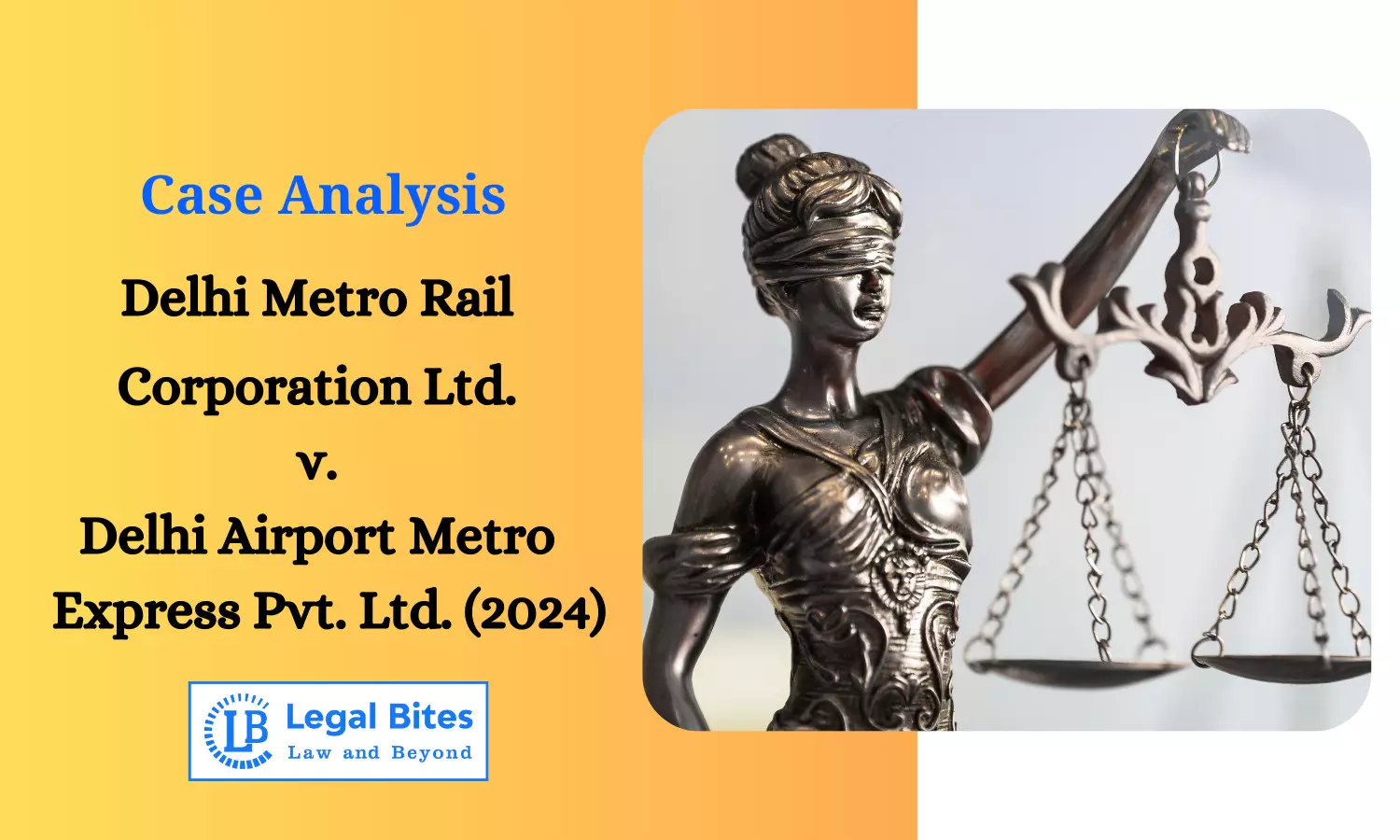Case Analysis: Delhi Metro Rail Corporation Ltd. v. Delhi Airport Metro Express Pvt. Ltd. (2024) | Curative Petition against Arbitral Award
The Supreme Court ruled in favour of DMRC's Curative Petition, overturning the arbitral award in favour of Delhi Airport Metro Express.

The Supreme Court, upon reviewing the curative petition filed by Delhi Metro Rail Corporation (DMRC), concluded that the previous judgment, which overturned the decision of the Division Bench of the Delhi High Court and reinstated the arbitral award, had indeed led to a miscarriage of justice.
Case Title: Delhi Metro Rail Corporation Ltd. v. Delhi Airport Metro Express Pvt. Ltd.
Court: Supreme Court of India
Citation: Curative Petition (C) Nos.108-109 of 2022
Petitioner: Delhi Metro Rail Corporation Ltd.
Respondent: Delhi Airport Metro Express Pvt. Ltd.
Judges: CJI D.Y. Chandrachud, Justice B R Gavai, Justice Surya Kant
Date of Judgment: April 10th, 2024
Facts
Before discussing the facts of the case at hand, it is important to understand the background and origin of the two companies involved in the case. DMRC (Delhi Metro Rail Corporation) is a wholly state-owned company which belongs to the Government of India and the National Capital Territory of Delhi. This is the petitioner in the case, while the respondent company, Delhi Airport Metro Express Private Limited (‘DAMEPL’) is an SPV (special purpose vehicle) which has been formed by a consortium comprising Reliance Infrastructure Limited and Construcciones Y Auxiliar de Ferrocarriles SA, Spain.
Now let us understand the factual background of this case. DAMEPL got a contract in 2008 to construct, operate and maintain the Delhi Airport Metro Express Ltd. The agreement was a concession agreement and stated a unique type of “public-private partnership” for providing metro connectivity between New Delhi Railway Station and the Indira Gandhi International Airport and other points within Delhi.
As per the contract, DAMEPL was bound to complete the construction process and other facets of the project within 2 years. Along with this, it had also been instructed to maintain the said metro line till the year 2038. In 2012 however, DAMEPL approached DMRC for extending their contract and time for concessional fee payable by DAMEPL. In furtherance, DAMEPL halted the metro operations stating that it was unsafe for usage.
On 8 October 2012, DAMEPL issued a notice to terminate the said 2008 contract. DMRC then initiated arbitration and an award was passed in favour of DAMEPL against which DMRC approached the High Court. The appeal was then partly allowed by the division bench of the High Court and this gave rise to the curative petition being filed by DAMEPL post rejection of their plea filed previously under Article 136.
Issues
The following issues have been decided upon by the Supreme Court in the said case:
- Whether the curative petition is maintainable?
- Whether the decision of the Supreme Court to reinstate the arbitral award, previously overturned by the High Court's division bench is justified.
Judgment
The Supreme Court said,
The curative jurisdiction should not be used to open the floodgates and create a fourth or fifth stage of court intervention in an arbitral award, under this Court’s review jurisdiction or curative jurisdiction, respectively.
The court before delving into the intricacies of the case, discussed the necessity to maintain the minimal level of judicial intervention in the arbitral award. Thus, the judicial contours of Section 34 were minutely observed and examined by the Supreme Court. The court examined that since the object of the Arbitration Act is to minimize judicial intervention, it would be appropriate for the court to not involve itself in the appreciation or re-appreciation of facts or law under Section 34.
The court further went on to highlight the instances where it is apt for the court to intervene in an arbitral award which majorly includes instances whereby the arbitrator has acted mindlessly and given a decision that no man of ordinary prudence would give. It also includes instances whereby the arbitrator has moved away from the contract and thus committed an error of jurisdiction.
Next, the court also discussed the ambit of patent illegality under which the said award had been set aside by the High Court’s division bench. The court stated that it is imperative that the illegality must lie at the root of the said matter and mustn’t be superficial. Thus, it would be incorrect to say that every error of law would lie under the category of ‘patently illegal’.
As per the court, the arbitral award could be stated to be patently illegal if based on no evidence ignores vital evidence, or fails to state reasons. Before giving the final judgment, the court also emphasized the “public policy of India”. The court stated that if any arbitral award leads to the court deciphering that the same has impacted the consciousness of the court, then the same would be taken to conflict with the basic notions of justice.
The Court, therefore, observed that the judgment of the two-judge Bench, which interfered with the judgment of the Division Bench of the High Court, has resulted in a miscarriage of justice and that it applied the correct test in holding that the arbitral award suffered from the vice of perversity and patent illegality.
- DAMEPL had taken accord with the period as provided in the contract the termination notice had been issued accordingly.
- DMRC was not permitted to hide in the guise of the certificate and contend that defects had been cured.
- The arbitrator’s view of including capital cost under adjusted equity in the compensation thus provided to DAMEPL was a noteworthy decision.
- The division bench had re-appreciated the facts and substituted its view with the arbitral tribunal’s which is outside the purview of Section 34.
The Supreme Court said,
"In the specific facts and circumstances of this case to which we have adverted in the course of the discussion, we have come to the conclusion that this Court erred in interfering with the decision of the Division Bench of the High Court. The judgment of the Division Bench in the appeal under Section 37 of the Arbitration and Conciliation Act 1996 was based on a correct application of the test under Section 34 of the Act. The judgment of the Division Bench provided more than adequate reasons to come to the conclusion that the arbitral award suffered from perversity and patent illegality."
Click Here to Read the Official Judgment
Conclusion
As we have read above, the said judgement has once again reiterated the restrictions posed in Section 34 and the judicial intervention of the courts in arbitral awards. The court has thereby elaborated on the concepts of ‘patent illegality’ and ‘public policy of India’ which often require sufficient description for application. Thus this can be understood as an attempt of the Hon'ble Supreme Court to enhance the objectives of the Arbitration and Conciliation Act, 1996.

